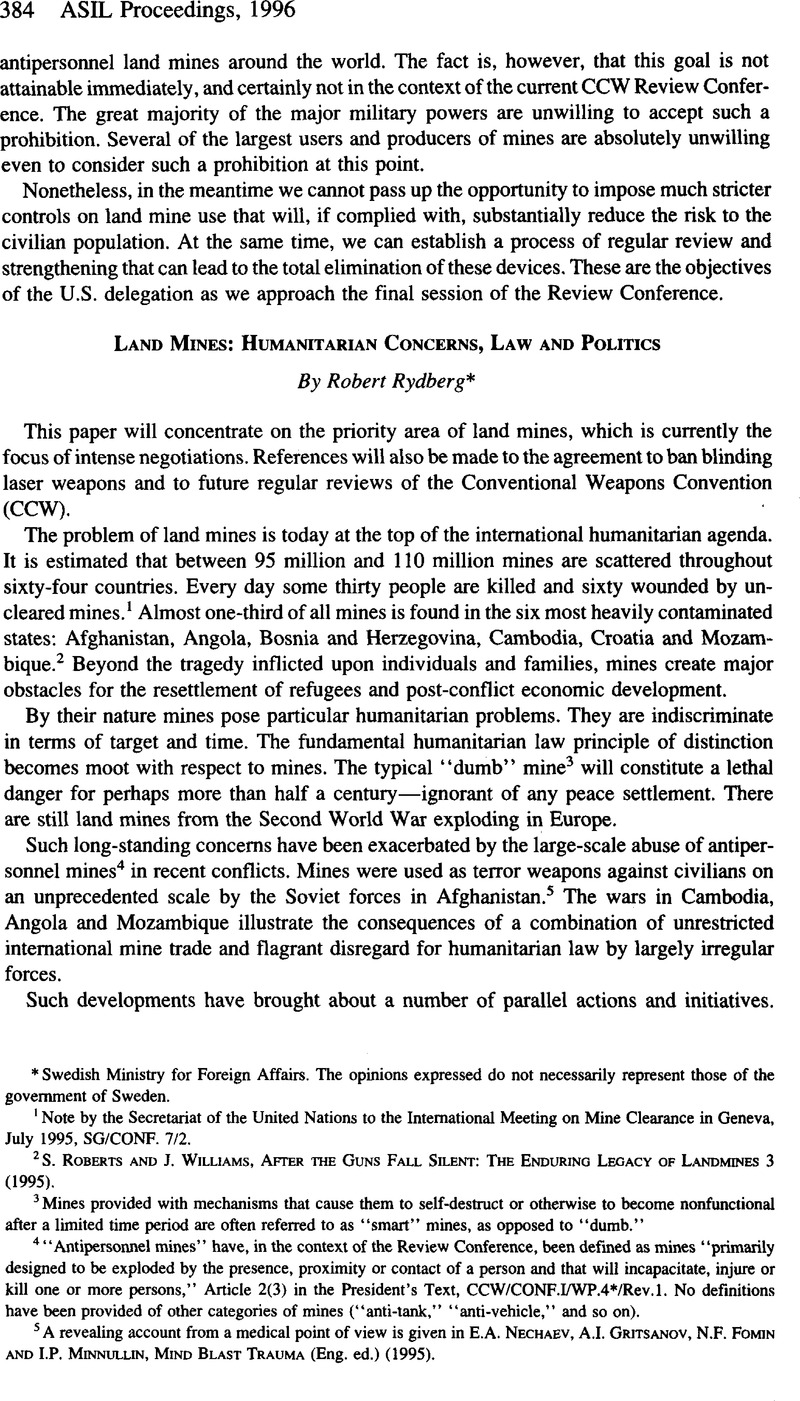No CrossRef data available.
Article contents
Land Mines: Humanitarian Concerns, Law and Politics
Published online by Cambridge University Press: 17 February 2017
Abstract

- Type
- A Look at Current Action on the Conventional Weapons Convention of 1980
- Information
- Copyright
- Copyright © American Society of International Law 2015
References
* The opinions expressed do not necessarily represent those of the government of Sweden
1 Note by the Secretariat of the United Nations to the International Meeting on Mine Clearance in Geneva, July 1995, SG/CONF. 7/2.
2 Roberts, S. and Williams, J., After the Guns Fall Silent: The Enduring Legacy of Landmines 3 (1995)Google Scholar.
3 Mines provided with mechanisms that cause them to self-destruct or otherwise to become nonfunctional after a limited time period are often referred to as “smart“ mines, as opposed to “dumb.“
4 “Antipersonnel mines“ have, in the context of the Review Conference, been defined as mines “primarily designed to be exploded by the presence, proximity or contact of a person and that will incapacitate, injure or kill one or more persons,“ Article 2(3) in the President's Text, CCW/CONF.I/WP.4*/Rev.1. No definitions have been provided of other categories of mines (“anti-tank,“ “anti-vehicle,“ and so on).
5 A revealing account from a medical point of view is given in E.A. Nechaev, A.I. Gritsanov, N.F. Fomin and LP. Minnullin, Mind Blast Trauma (Eng. ed.) (1995).
6 The fund was set up pursuant to UN General Assembly Resolution 48/7 of October 19, 1993. See Eliasson, J.. An International Approach Toward Humanitarian Assistance and Economic Development of Countries Affected by Land Mines, in Clearing the Fields 165 (Cahill, K.M. ed., 1995)Google Scholar.
7 See the Report of the UN Secretary-General, UN Doc. A/50/701.
8 A list prepared by Human Rights Watch Arms Project (January 1996) includes Austria, Belgium, Cambodia, Canada, Denmark, Estonia, Iceland, Ireland, Laos, Malaysia, Mexico, Mozambique, New Zealand, Nicaragua, Norway, Peru, the Philippines, Slovenia, Sweden, Switzerland and Uruguay as supporting an immediate ban.
9 Convention on the Prohibition or Restrictions of the Use of Certain Conventional Weapons which may be Deemed to be Excessively Injurious or Having Indiscriminate Effects.
10 Article 1 of the Convention refers to situations under Article 2 common to the Geneva Conventions, including situations described in Article 1(4) of Additional Protocol I (anticolonial wars).
11 18 The United Nations Disarmament Yearbook 204, 1993.
12 UN Res. 48/79 (December 16, 1993).
13 CCW/CONF.I/l. The texts are available in UNIDIR Newsletter, No. 28/29, December 1994/May 1995.
14 Decision of the Council of the European Union (May 12, 1995). A Joint Action is the highest form of decision within the Common Foreign and Security Policy.
15 As the only state party, the United States thereby chose to exempt Protocol III.
16 As of March 11, 1996. Article 5(2) of the Convention stipulates that it enters into force for any state only six months after it has deposited its instrument of ratification, acceptance, approval or accession.
17 See, e.g., Molander, J., Getting Together to Ban the Use of Blinding Laser Weapons, Int'l Herald Trib., December 18, 1995 Google Scholar.
18 CCW/CONF.I/WP.4*/Rev.l (January 19, 1996). As stated in its introduction, the text reflects the stage of negotiations as seen by the President and does not commit any delegation. Footnotes to the text indicate main areas of disagreement.
19 Postcript: On May 3, 1996, the Review Conference concluded with the adoption of an amended Protocol II (CCW/CONF.I/14). Transition periods for detectability and self-destruction/self-deactivation were set at nine years from entry into force. In a political undertaking included in the Protocol, states parties agreed not to transfer any prohibited mines, as from the date of adoption. States undertook to impose criminal responsibility for individuals who, by contravening the Protocol, willfully kill or cause serious injury to civilians.
20 One major developing country, India, has advocated a complete ban on the transfer of any mines.
21 This ban would apply irrespective of any transition periods.
22 A distinction should be made between humanitarian mine clearance, which today necessitates detection, and military mine breaching, accomplished by clearing a path through a minefield. Nondetectability for anitper- sonnel mines today has little military value in conventional warfare. See Johnson, R.H., Why Mines? A Military Perspective, in Clearing the FieldsGoogle Scholar.
23 It is assumed that this is particularly the case of China and India, but low metallic mines are also part of the arsenals of many other states, including the United States and Sweden. On these concepts, see earlier discussion.
24 Sweden already during the negotiations on the original Protocol proposed a ban on remotely delivered mines—with little support. In the present negotiations the idea has been taken up particularly by India. Opposition to the idea continues, however, to be widespread and strong.
25 Biddle, S.D. and Klare, J., Military Utility and the Control of Land Mines, in UNIDIR Newsletter 22Google Scholar.
26 Possible topics mentioned for further consideration include small-caliber weapons and ammunition, as well as naval mines.
27 CCW/CONF.I/WP.l.


